I’ve always been a fan of the lush, feathery look of Cabomba caroliniana, or fanwort, in my aquariums. It’s not just gorgeous—it’s also great for the underwater ecosystem. Learning how to care for Green or Red Cabomba can seriously transform your tank into a stunning aquatic scene.
To get that perfect aquarium vibe, you need to dial in a few key conditions. Keep the water temperature between 68 and 82 degrees Fahrenheit, maintain a pH around 6.5, and aim for water hardness between 3 to 8 dGH. Nailing these basics sets up the ideal environment for your Cabomba to thrive.
Lighting is a big deal, too. Cabomba loves medium to high light for about 10 to 12 hours a day, which can make it grow like crazy—sometimes up to an inch a day! But with that fast growth comes the need for regular trimming. Keeping it trimmed not only prevents it from taking over but also gives you the chance to propagate new plants. It’s all about balancing light, water, and a little bit of care to keep your Cabomba looking its best.
Introduction to Cabomba as a Freshwater Aquarium Plant
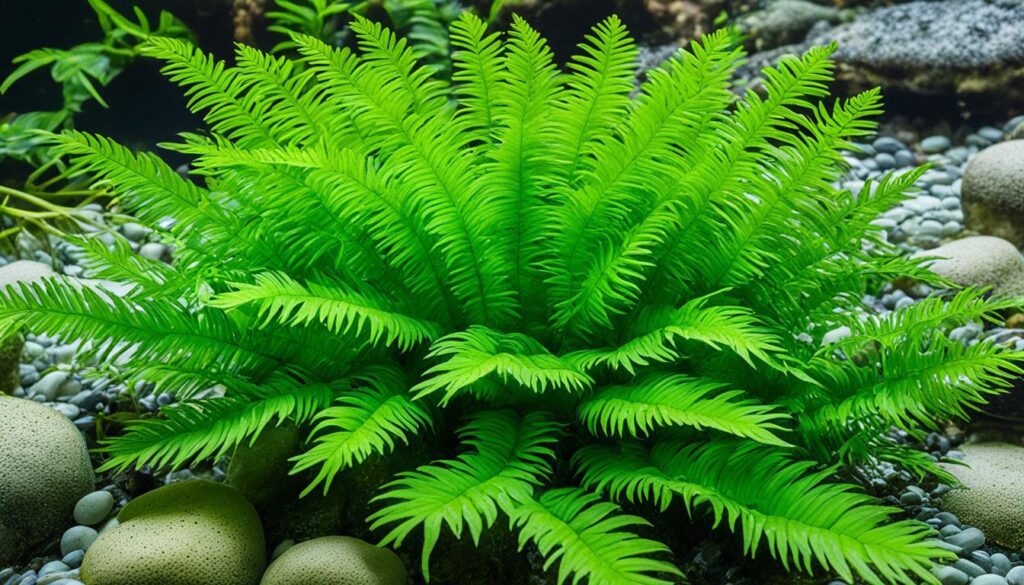
I’m excited to share my experience with Green Cabomba and Brazilian Fanwort. They are key players in my freshwater aquariums. These plants add beauty and help the ecosystem by offering oxygen and homes for aquatic life.
Aquarium greenery like Cabomba is popular for good reason. They adapt well and are easy to care for. This makes them great for newbies and pros in aquarium keeping.
- Maximum Growth: Can grow to 12-24 inches under the right conditions.
- Purchase Size: Usually sold at 5 to 8 inches, ideal for beginners.
- Preferred Lighting: Best with specific aquarium lights like Coralife’s Nutri Grow for strong growth.
My chats with other aquarium fans from places like Mountain View, Houston, and Versailles have shown mutual feelings. Cabomba is more than a plant— it’s essential in home aquariums.
Format of Sale |
Contents |
Packaging Type |
|---|---|---|
Bunched plants |
6 fresh-cut stems |
Foam with lead weight |
Potted plants |
6 fresh-cut stems |
Net pots with rock wool |
Getting plants shipped directly is very convenient. In my experience, they often arrive quickly and in good shape. This is because of a well-planned shipping method. Plus, orders for live plants are rushed to make sure they’re healthy when they get to you. This is part of their Live Arrival Guarantee.
My time with Cabomba plants has made my aquariums more vibrant and tranquil. They’re perfect whether you’re starting out or seeking reliable plants. Green Cabomba or Brazilian Fanwort can make your tank look and feel better.
The Distinct Varieties of Cabomba: Green and Red
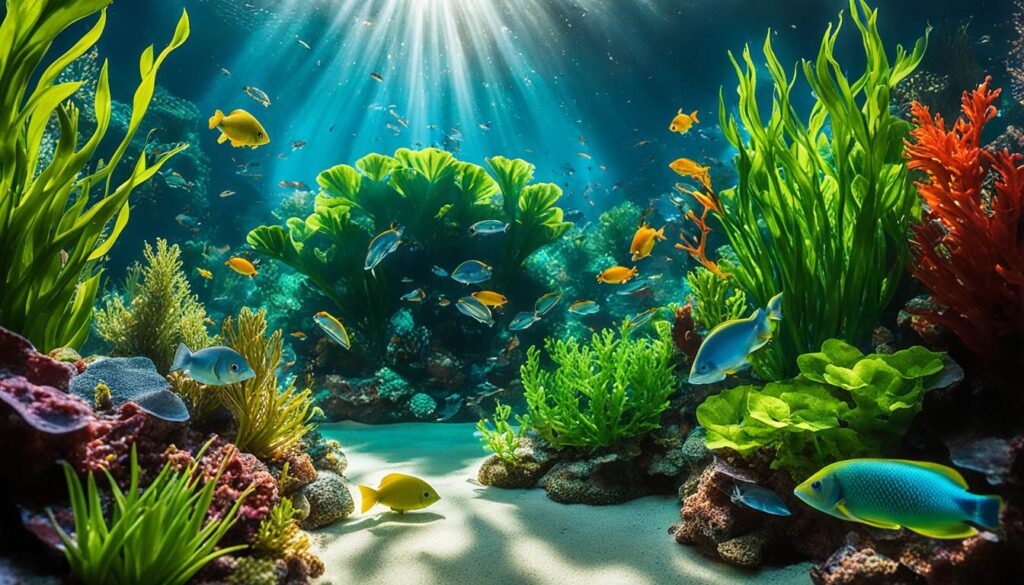
I love exploring different aquarium plants. Cabomba species have really caught my eye. They not only look great but also come in types that meet various care needs and looks.
Characteristics of Green Cabomba
Cabomba caroliniana, or Green Cabomba, has bright green stems and full, brush-like leaves. It’s easy to find for aquarium lovers. This type does well in many water settings, attracting beginners and experts alike. It prefers temperatures of 72 – 82 degrees Fahrenheit, and needs good lighting to keep its color and thick leaves. Yet, it doesn’t mix well with rough fish like cichlids and goldfish, which can harm its soft leaves.
Exploring the Rarity of Purple Cabomba
Purple Cabomba, or Cabomba furcata, is known for its eye-catching reddish-purple leaves. It’s less common, perfect for those wanting a unique tank. Compared to Green Cabomba, it needs more light and care, including extra CO2 and special fertilizers. These help it grow strong and keep its special color.
Species |
Common Name |
Color |
Light Requirements |
Care Difficulty |
|---|---|---|---|---|
Cabomba caroliniana |
Green Cabomba |
Green |
Medium to High |
Moderate |
Cabomba furcata |
Purple Cabomba, Red Fanwort |
Reddish Purple |
High |
Challenging |
Choosing between Green Cabomba and Purple Cabomba can be tough. Both add their own special look and feel to your tank. Plus, they help keep the tank’s environment balanced by filtering the water and offering shelter to fish and other creatures.
Essential Tips for Selecting Healthy Cabomba Plants
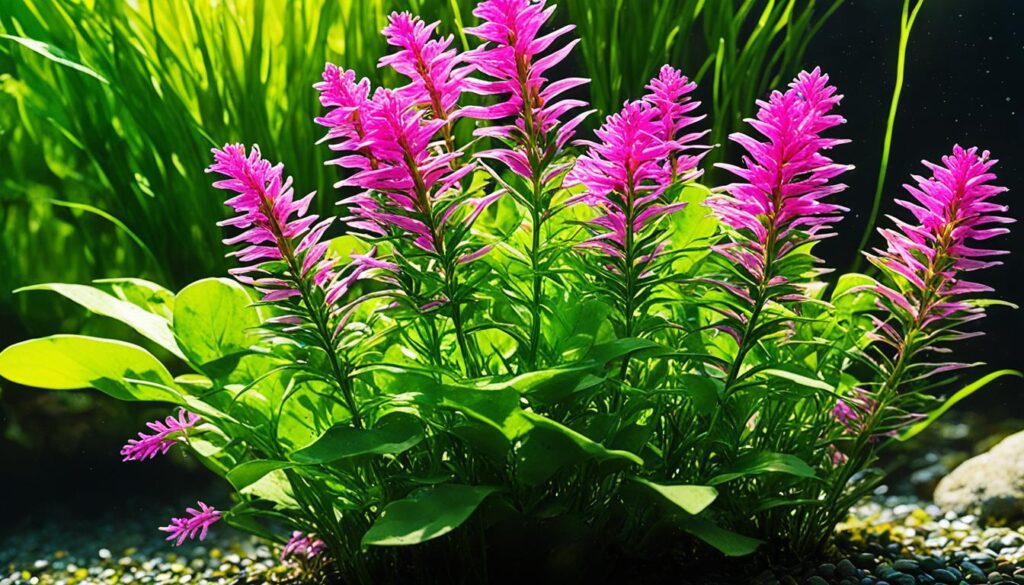
When you’re setting up an aquarium, Cabomba is a top choice for its beauty. But finding healthy plants can be hard, especially if you’re new to this. Here are some key tips to help you pick the best Cabomba for your tank.
Length and Color of Stems as Health Indicators
Look for Cabomba stems that are at least six inches long. They should also have a vibrant color. This shows they’re healthy. Avoid stems with splits or cracks. These could mean the plant is sick or was handled poorly.
Recognizing New Growth and Potential Flowers
Healthy Cabomba will have new leaves or flower buds. This means the plant is strong. It will likely do well in your aquarium. Finding flowers? That’s great! They’ll make your underwater garden even prettier.
Plant Growth Feature |
Weekly Growth |
Additional Care Notes |
|---|---|---|
1+ inch |
Thrives without high light or CO2 |
|
Sunset Hygro Poly |
1+ inch |
Resistant to fish nibbles |
0.8 watts/gallon light sufficient |
Low light requirement |
Choosing Cabomba wisely involves knowing about aquarium planting. Make sure your plants got the right light and nutrients. Reading reviews from other aquarium lovers can help too.
Selecting the right Cabomba is important. It means your plants will last longer and look more vibrant. Enjoy your planting!
The Art of Planting Cabomba in Your Aquarium
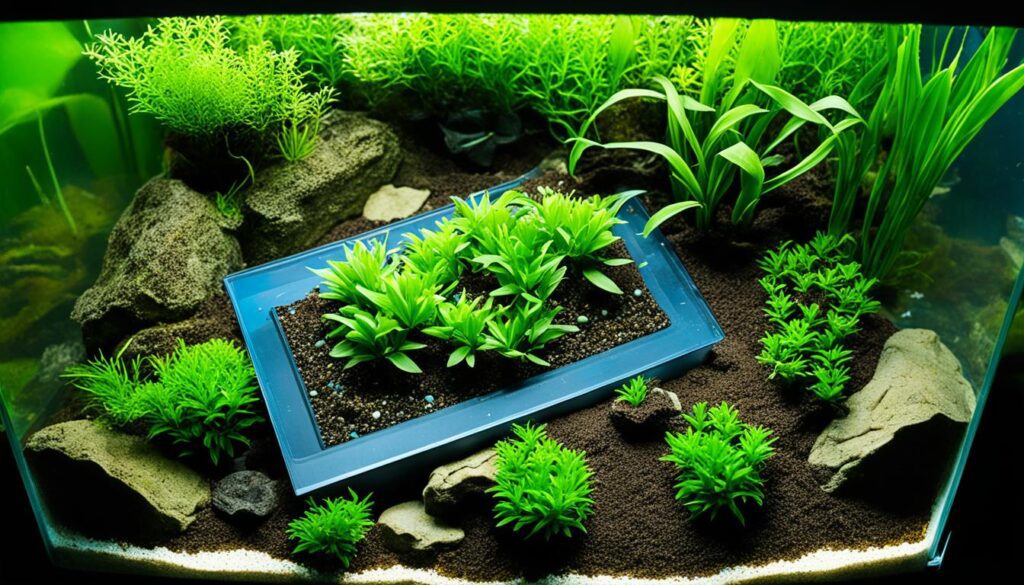
Starting with planting aquarium plants like Cabomba blends art with science. When I get the plants ready, it’s all about being precise. I carefully remove the Cabomba from its rubber band. I make sure each stem is free without breaking. A quick wash under cool water gets rid of unwanted leaves. This step helps stop decay.
Then, comes the careful trimming of the stems. I cut off any worn-out sections to help the plant grow again and stop rot. Planting is next; I insert the trimmed stems into nutrient-rich soil. Proper arranging of freshwater plants looks good and gives each plant space to grow. This also helps keep them from being uprooted.
My big goal is to create a dense, lush aquarium forest. This forest is not just beautiful. It provides a great home for all the aquarium’s creatures.
Product Details |
Statistics |
|---|---|
Items Available |
More than 10 Cabomba units |
Price per Item |
US $12.99, approx ILS 47.88 |
Total Sales |
717 units sold |
Seller Location |
Opa-Locka, Florida, United States |
Shipping Policy |
No shipping to Israel, returns not accepted |
Cabomba Care Challenges: Light and Nutrient Requirements
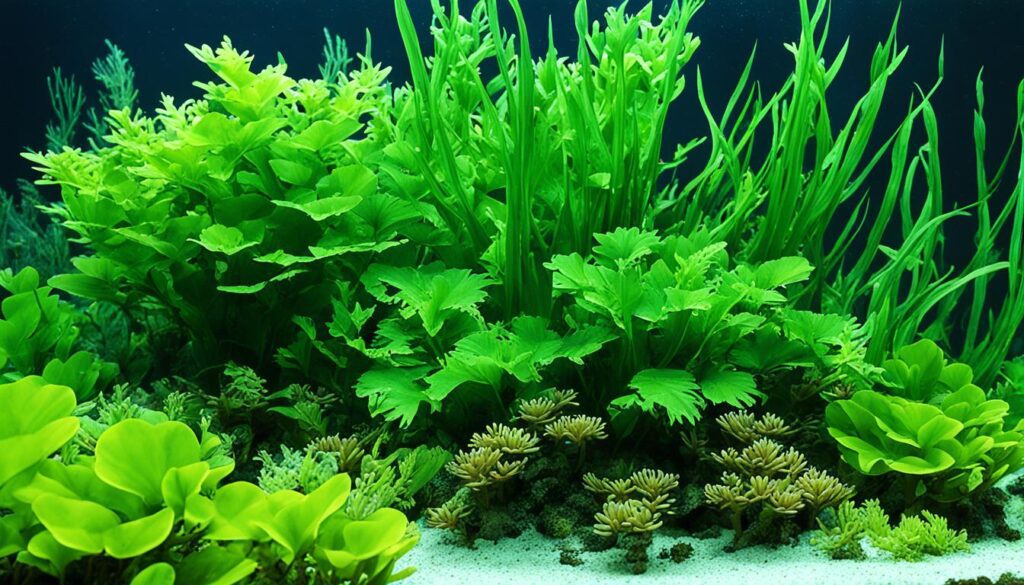
To care for Cabomba plants well, you need to know about their light and nutrient needs. Let’s talk about how important aquarium lighting, aquatic plant fertilization, and CO2 for plants are. These factors help these beautiful background aquarium plants grow vibrant and full.
Necessity of Adequate Lighting
Light is essential for Cabomba plants. They need up to three watts of light per gallon of water. This is especially true for Red and Purple Cabomba, which need a lot of light. If they don’t get enough light, their stems stretch out, and they don’t grow as many leaves.
Fertilization for a Thriving Plant
Fertilizing aquatic plants is key for Cabomba to flourish. These plants thrive with iron and other important minerals. You can use liquid fertilizers or root tabs to give them these nutrients. Without enough nutrients, Cabomba might not grow vibrant and full.
The Role of CO2 Supplementation in Cabomba Care
Adding CO2 for plants helps Cabomba grow better. It leads to a strong root system and fuller leaves. While Green Cabomba can grow without CO2, adding it encourages healthier, stronger plants. It also helps them compete with algae.
Let’s examine how different conditions impact Cabomba, based on research:
Condition |
Impact |
|---|---|
High Light |
One researcher found optimal growth in bright light, but less in medium light. |
Temperature and Water Parameters |
Best growth at 80-84°F, with a pH of 6.0-6.5, and hardness around 9 dH. |
3-Day Blackout |
Red Cabomba lost 20% of its mass and density. |
Floating with Adequate Light |
Stems grew roots between nodes in 5 days, leading to denser growth. |
Floating Cabomba |
The plant had more branches, which made it look better and cover more area. |
This in-depth look at Cabomba care highlights how vital the right conditions are for the plant.
Understanding Water Conditions for Optimal Cabomba Growth
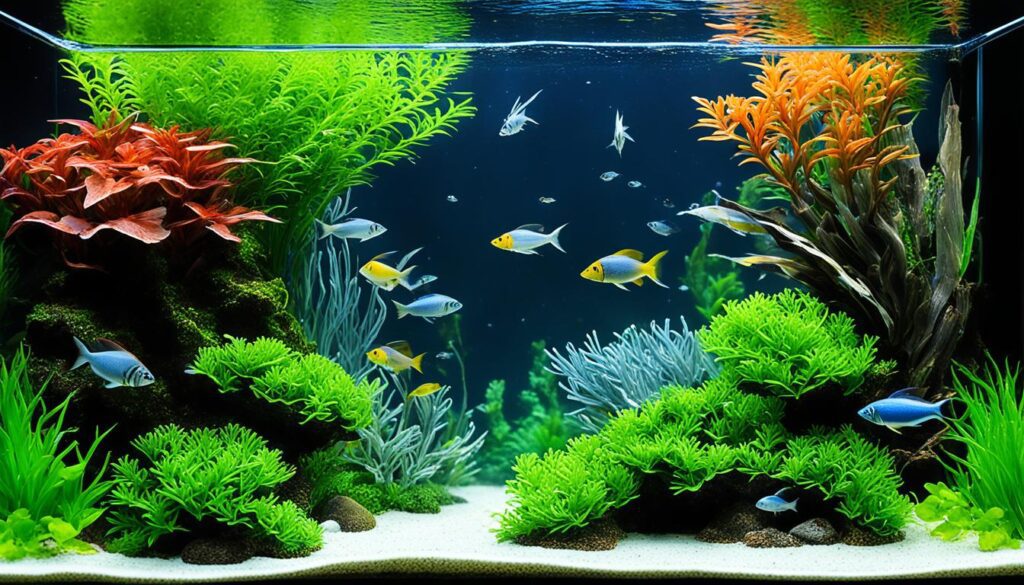
To create the best environment for Cabomba in your aquarium, you need to know about the water. The plant’s growth and health rely on water movement, pH, temperature, and tank size. These should be as close to the plant’s natural home as possible.
Water Movement and Tank Placement
Cabomba does well with soft water movement. This helps spread nutrients evenly without hurting the plant’s leaves. Put your aquarium where things like air conditioners or sudden temperature changes won’t affect the water much. This ensures your Cabomba grows well.
The Ideal pH and Temperature for Cabomba
The best pH levels for Cabomba are between 6.8 and 7.5. This means the water is a bit acidic to neutral. Cabomba caroliniana likes warm water, best between 72-82°F (22-28°C). It’s important to keep the temperature steady. Big changes can stress the plants and slow down their growth.
Tank Size Considerations for Plant Health
It’s key to have a tank big enough for Cabomba’s growth. In small tanks, conditions change fast, stressing the plant. Bigger tanks offer more stable conditions and give Cabomba space to grow. It usually does well in tanks that are at least 46 gallons or bigger.
Parameter |
Typical Value |
Optimal Value |
|---|---|---|
Water Temperature |
78-80°F |
72-82°F |
pH Level |
Varies |
6.8-7.5 |
Lighting Duration |
9.5 hrs/day |
12 hrs/day |
Water Changes |
70% weekly |
As per need |
Tank Size |
Variable |
Minimum 46 gallons |
Stems, Leaves, and Roots: Intricacies of Cabomba Anatomy
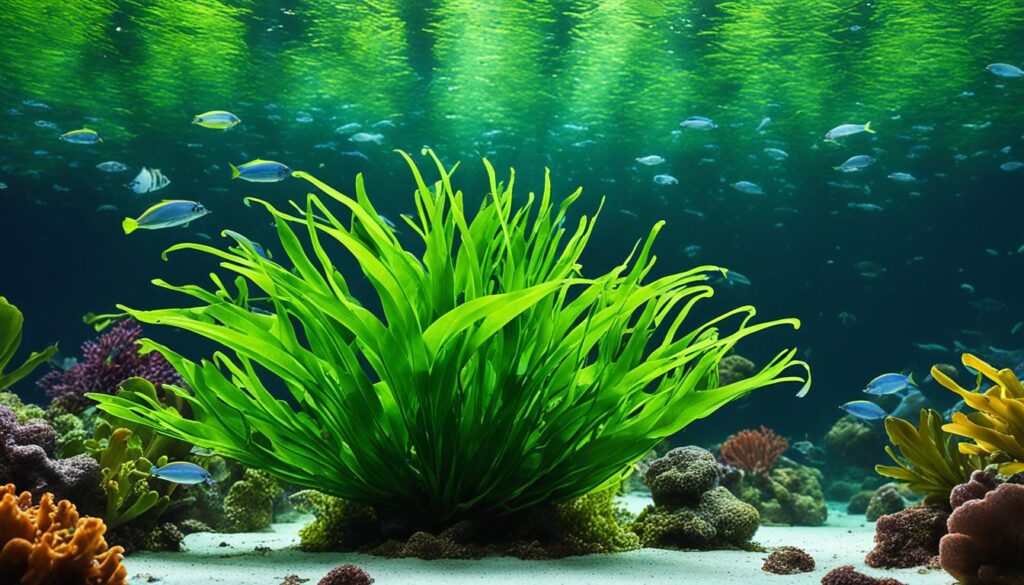
If you want your aquarium presentation to pop, get to know Cabomba. Its stems are long and bushy, reminding one of bottle brushes. They’re perfect for the back parts of a tank. Cabomba leaves are soft and silky, trapping food for shrimp.
The roots of Cabomba are amazing too. They look like thin white strings and help the plant stick to the bottom. Be gentle with these roots when you’re planting. They’re easy to hurt but crucial for the plant’s growth.
Cabomba’s roots are different from some other aquatic stem plants:
Plant |
Root Type |
Description |
|---|---|---|
Cabomba |
Fine, hair-like |
Extremely delicate, requires gentle handling during planting |
Rhizomatous |
Thick, creeping roots that can attach to rocks and wood |
|
Ludwigia |
Fibrous |
Densely branched, supporting faster growth |
Cabomba isn’t just pretty. It plays a big role in your tank’s environment. Cabomba leaves and roots help clean the water. This makes your aquarium healthier. It’s why so many aquarists love it.
Choosing plants like Cabomba can really enhance your aquarium. Pay attention when planting, and give it room to grow. It will turn your tank into a beautiful underwater scene.
Cultivating a Substrate Suitable for Cabomba
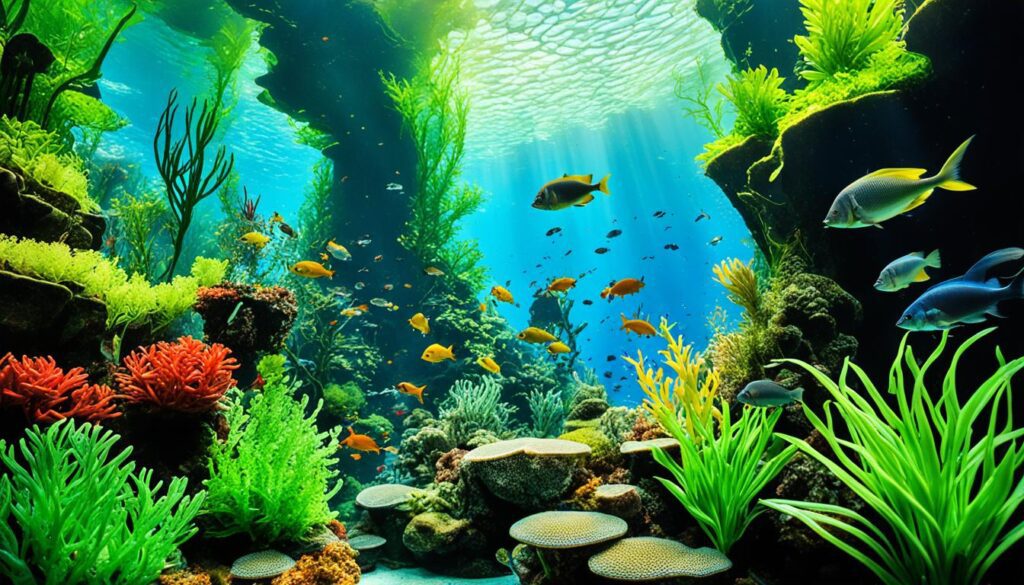
If you love aquascaping, learning to make the best home for Cabomba starts at your tank’s bottom. Here, the aquarium substrate is key. It’s important not only for looks but also for helping plants grow their roots and stay healthy.
Choosing the Right Substrate Composition
What you put at the bottom of your tank matters a lot for Cabomba growth. A fine, nutrient-packed aquatic soil is best since it lets you plant stems easily and roots can grow well. Also, this kind of ground helps keep the water just right for plants to grow better, as many aquarium fans agree. They’ve seen good results.
Ensuring Proper Plant Spacing and Depth
Putting Cabomba in the right spot is key to keeping them grounded. They should be planted 2-3 inches deep for stability. Also, make sure they’re not too close together. This lets each plant get enough light and food to do well. Clipping them regularly keeps them the right distance apart, making sure they grow full and avoid getting too crowded.
Picking the best substrate is crucial. It does more than just keep plants in place. It also makes sure they get the nutrients they need for strong growth.
Maintaining Cabomba: Pruning and Controlling Growth
I love keeping my aquarium in top shape, and a big part of that is pruning plants. Cabomba grows fast, needing lots of care. In my big fish tank, I’ve seen how much people like talking about taking care of Cabomba. It’s gotten over 2,000 views online! People share tips and pictures, making learning about Cabomba fun.
Trimming Techniques for Healthier Plants
Keeping Cabomba under control requires regular trimming. I make careful cuts to keep the plants healthy and ensure they get enough light. This also stops the tank from getting too crowded. Every week, I change some of the water and check the temperature. It helps keep the plants and fish happy.
It’s also important to watch what nutrients I add to the water. I use Iron, Flourish Excel, and a special liquid for little plants. I adjust these based on how the plants are doing and what I see.
Utilizing Cuttings for Propagation
After pruning, I use the healthy pieces to grow more Cabomba. I either plant them back in the tank or let them float. Sharing these cuttings with my friends is really rewarding. Plus, keeping the tank light on for just 8 hours a day and checking the water keeps everything in balance.
Adding different plants like Marimo Moss Balls and Dwarf Hairgrass makes the aquarium more interesting. Each plant has its own care needs. This makes taking care of the aquarium a rich experience.








